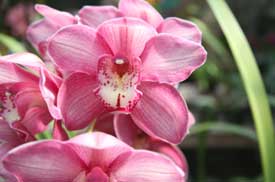
John Day (1824 – 1888) was a prominent orchid grower and enthusiast of the Victorian era. With color photography a long way off, Day painted watercolors of orchids. He worked with great clarity, for the information in his lovely paintings tells the observer all he or she needs to know about a particular plant or flower. His renderings had verve and style; he had a remarkable talent for keeping his work fresh and alive.
He created a series of over fifty scrapbooks containing nearly three thousand exquisitely detailed drawings and watercolors of these plants over a quarter of a century. For some 40 years, Day acquired newly collected plants, cultivated them in his own glasshouses and brought many into flower for the first time in England. For him, as for many Victorians, these astonishing plants undoubtedly came to represent a vision of paradise.
Produced in association with the Royal Botanic Gardens, Kew, the book A Very Victorian Passion: The Orchid Paintings of John Day, is filled with hundreds of exquisite watercolors of the newly discovered orchids that entranced Victorian society. This stunning archive of 280 orchid illustrations is introduced and thoroughly explored by leading authorities, Philip Cribb and Michael Tibbs, with the history, background, and botany of the orchids included.
Kew Gardens has an exhibition you can visit, too, in person or online. These flowers, ranging from the elegant to the curious, were given added appeal by tales of exotic lands, eventful plant hunting missions and resourceful collectors. And you can explore the romance of orchid discovery online as well.
The American Orchid Society includes a review that concludes, “Here, then, is a book of importance for everyone generally interested in orchids, and especially for botanical artists. It is a comprehensive book in every respect, to be cherished not only for Day’s paintings and the authors’ quality of writing, but also for its excellence of reproductions and printing.”

Copyright Just Add Ice® Orchids 2023